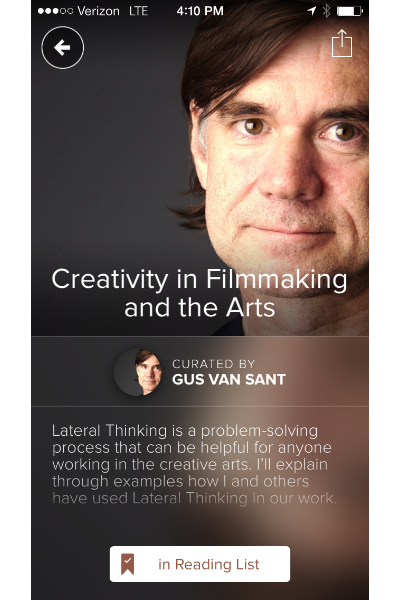
Silicon Valley startups like to talk about an act known as pivoting — dropping fundamental aspects of whatever your startup’s doing, or maybe all of them, in favor of doing something meaningfully different with (in theory, at least) a higher chance of success. It happens frequently. But it’s even more common for a small company that isn’t yet a breakout success to just go through lots of little twists and turns until it ends up a distinctly different beast than it was in the beginning.
I thought of that while looking at the new version of Learnist’s iPhone app. Learnist started out as an offshoot of Grockit, a social test-preparation service that ended up being sold to test-prep kingpin Kaplan. In its earliest, web-based form, Learnist was reminiscent of Pinterest, but focused on letting people assemble instructional material by pulling together material from around the Net, such as articles and YouTube videos. Over time, it added iOS and Android apps, and de-emphasized academic topics at least a little bit in favor of allowing anybody to convey useful information about anything.
And now Learnist is zigging (or maybe zagging?) again. It’s released a new version of its iPhone app, and though it still lets you dive into to the vast quantities of content that all sort of folks have been creating and collating, the app also tries to play up just a little bit of content, produced by well-known contributors rather than anybody and everybody.
Learnist has looked less and less like Pinterest over time, and rather than throwing you into a Pinterest-style ocean of stuff, the new app lets you browse lessons (called “learnboards”) in a tidy environment that the company calls a digital bookstore. (As you find items of interest, you can add them to a Reading List for later perusal.) The learnboards now include for-pay ones as well as freebies; they cost 99 cents a pop, and the company is signing up people like film director Gus Van Sant, actress Olivia Wilde and author Brad Meltzer to create some of them.
An investment of under a buck isn’t much, but the fact that the content carries a cost and was produced by people noted in their field does seem to have an impact on what Learnist is trying to deliver. Using my iPhone, I sampled a learnboard by Van Sant (“Creativity in Filmmaking and the Arts”) and one by Wilde (“Badass Women Fighting for Justice”), and both felt less like curation and more like medium-sized articles with photos and links to related content. In some ways, that’s better suited to the iPhone than Learnist’s old-school material, since on the phone, links to videos and sites pop up in a web view inside the app, in an ungainly manner. (The browser-based version of the service, which doesn’t yet have paid content, has embedded video and lets you hop around inside and outside of Learnist more smoothly.)
Content from notable authors is a fun addition — especially when, as with Van Sant’s learnboard, they tell you how they do what they do. But I hope that Learnist continues to pursue its original mission of being an everyperson’s platform for teaching, too. It’s a powerful idea, and the company hasn’t exhausted all of its possibilities yet.
More Must-Reads from TIME
- Donald Trump Is TIME's 2024 Person of the Year
- Why We Chose Trump as Person of the Year
- Is Intermittent Fasting Good or Bad for You?
- The 100 Must-Read Books of 2024
- The 20 Best Christmas TV Episodes
- Column: If Optimism Feels Ridiculous Now, Try Hope
- The Future of Climate Action Is Trade Policy
- Merle Bombardieri Is Helping People Make the Baby Decision
Contact us at letters@time.com